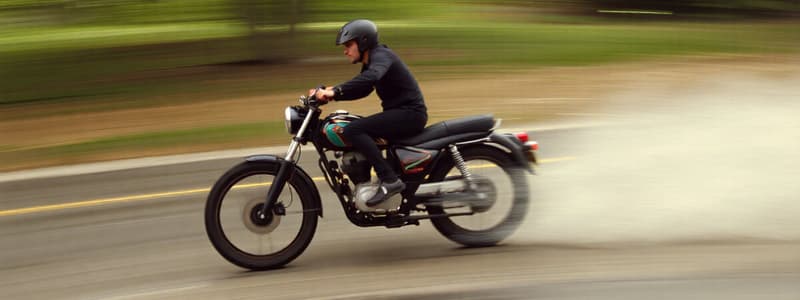Podcast
Questions and Answers
How is average speed calculated?
How is average speed calculated?
- By determining the maximum speed reached during the journey
- By dividing the total distance traveled by the total time taken (correct)
- By measuring the slope of a distance-time graph
- By averaging instantaneous speeds over time
What defines instantaneous speed?
What defines instantaneous speed?
- The speed at a specific moment in time (correct)
- The speed determined from the slope of the speed versus time graph
- The average speed calculated across the entire journey
- The speed measured over a period of time
What does the slope of a distance-time graph represent?
What does the slope of a distance-time graph represent?
- Direction of motion of the object
- Instantaneous speed of the object
- Average speed of the object (correct)
- Acceleration of the object
Which statement best describes the relationship between speed, velocity, and acceleration?
Which statement best describes the relationship between speed, velocity, and acceleration?
What is the average speed of a racecar that traveled 80 kilometers in 0.4 hours, 114 kilometers in 0.6 hours, and 80 kilometers in 0.4 hours?
What is the average speed of a racecar that traveled 80 kilometers in 0.4 hours, 114 kilometers in 0.6 hours, and 80 kilometers in 0.4 hours?
In which scenario would the average speed be less than instantaneous speed?
In which scenario would the average speed be less than instantaneous speed?
How can acceleration be determined from a graph?
How can acceleration be determined from a graph?
What type of quantity is speed considered?
What type of quantity is speed considered?
What is the main difference between a scatter plot and a line graph?
What is the main difference between a scatter plot and a line graph?
What does the slope of the best fit line represent on a distance versus time graph?
What does the slope of the best fit line represent on a distance versus time graph?
Which statement about velocity is true?
Which statement about velocity is true?
What does a change in velocity signify regarding acceleration?
What does a change in velocity signify regarding acceleration?
Considering a graph of distance versus time, what could explain the slope if it is constant?
Considering a graph of distance versus time, what could explain the slope if it is constant?
If a student indicates the average speed of a ball rolling 6 m in 2 s is 1.5 m/s², what error is present in their reasoning?
If a student indicates the average speed of a ball rolling 6 m in 2 s is 1.5 m/s², what error is present in their reasoning?
How can you determine if two graphs, one of distance versus time and another of speed versus time, represent the motion of the same object?
How can you determine if two graphs, one of distance versus time and another of speed versus time, represent the motion of the same object?
When is acceleration considered to be occurring?
When is acceleration considered to be occurring?
Flashcards
Line of Best Fit
Line of Best Fit
A line drawn on a scatter plot that best represents the relationship between data points.
Acceleration
Acceleration
The rate at which an object's velocity changes. This can be a change in speed, direction, or both.
Velocity
Velocity
The speed at which an object travels in a particular direction. It combines both speed and direction.
Speed on Distance-Time Graph
Speed on Distance-Time Graph
Signup and view all the flashcards
Scatter Plot
Scatter Plot
Signup and view all the flashcards
Distance-Time Graph
Distance-Time Graph
Signup and view all the flashcards
Calculating Acceleration
Calculating Acceleration
Signup and view all the flashcards
Distance-Time Graph
Distance-Time Graph
Signup and view all the flashcards
Speed
Speed
Signup and view all the flashcards
Slope
Slope
Signup and view all the flashcards
Average Speed
Average Speed
Signup and view all the flashcards
Instantaneous Speed
Instantaneous Speed
Signup and view all the flashcards
Variable
Variable
Signup and view all the flashcards
Study Notes
Unit 2: Forces and Motion - Lesson 2: Speed, Velocity, and Acceleration
- Objectives: Students will determine average speed from calculations and distance-versus-time graphs. Students will compare and contrast velocity, speed, and acceleration using text evidence. Students will interpret graphs to determine acceleration.
- Guiding Questions: How do you determine speed from calculations and distance-versus-time graphs? How is velocity related to speed and acceleration? How can you interpret graphs to determine acceleration?
- Vocabulary: speed, slope, velocity, acceleration, average, variable
- Calculating Speed: Speed is the distance an object moves per unit of time. It is a type of rate, where a rate tells the amount of something that occurs in one unit of time.
- Calculating Speed (formula): Speed = Distance / Time. Units for speed express distance over time (e.g., kilometers per hour, meters per second).
- Example Problems: Various example problems illustrating calculations of speed are provided, involving different distances and times.
- Instantaneous and Average Speeds: Average speed is calculated by dividing the total distance travelled by the total time. It does not reflect speed at every moment in time. Instantaneous speed is the speed at a specific time.
- Example Problems (continued): Additional problems, including examples of a race car at the Daytona 500 and an airplane on a runway.
- Calculating Speed from Distance-Time Graphs: Points on a scatter plot (distance-time) are not connected. A line of best fit can help predict outcomes based on the data. The slope of this line represents the speed.
- Calculating Speed from Distance-Time Graphs (formula): Speed = rise / run = change in distance / change in time.
- Describing Velocity: Velocity is the speed of an object in a given direction. It incorporates both speed and direction. Velocity is a vector.
- Determining Acceleration: Acceleration is the rate at which velocity changes. Changes in velocity can involve speed, direction, or both. Acceleration occurs as an object speeds up, slows down, or changes direction.
- Calculating Acceleration (formula): Acceleration = (final speed - initial speed) / time.
- Model It! Applying the concepts of acceleration to identify changes in speed.
- Acceleration in Racing: Acceleration can be increasing or decreasing speed, or changing direction. Examples are provided in racing.
- Acceleration of a Plane: A plane accelerates as it takes off, but then decelerates during flight.
- Graphing Acceleration: Worksheet for graphing acceleration.
- Lesson 2 Check: Questions assessing understanding of acceleration, including an average speed question for a train and a ball rolling experiment.
Studying That Suits You
Use AI to generate personalized quizzes and flashcards to suit your learning preferences.




